Identifying Shoe Wear Patterns for Kids with Foot Problems
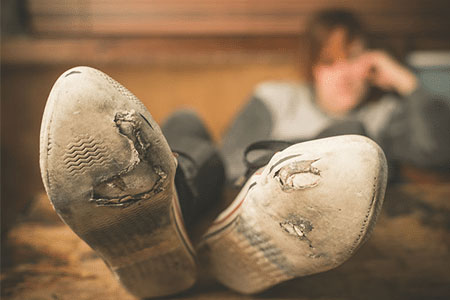
Have you noticed your child walking or running differently and you suspect your child is dealing with a foot condition such as flat feet? When it comes to identifying foot problems, the condition of your child’s footwear is more important than you might realize. Paying attention to how your child’s shoes wear down can provide valuable insights into their overall foot health, walking patterns, and can even signal potential issues that may need a professional’s attention. I am going to help you figure out what foot condition your child has based on his or her shoe wear patterns.
Figuring Out Your Child’s Foot Condition Early Can Make a World of Difference!
A child’s gait – that is, the way they walk – will directly influence how their shoes wear over time. Think of it as a sort of footprint diary; the wear patterns on your child’s shoes can tell you if their feet roll inward too much, known as overpronation, or if there’s too little inward movement, referred to as supination. Identifying these early can help you and your healthcare provider take steps to correct imbalances and support proper foot development.
I am an expert when it comes to fitting children’s shoes as I have worked for a specialized children’s shoe store for over a decade. It’s not uncommon for children to be unable or unwilling to communicate foot discomforts, so being vigilant about their shoes is a proactive way to keep them striding comfortably and healthily.
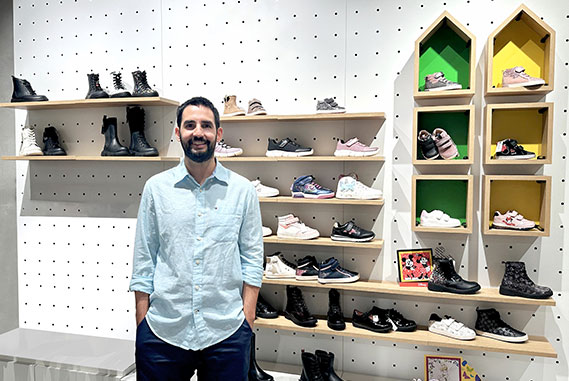
One of the most common signs that your child might be dealing with a foot condition is when you notice your child’s shoes caving in as shown in the image below. That’s a sign that your child might be dealing with flat feet and overpronation.
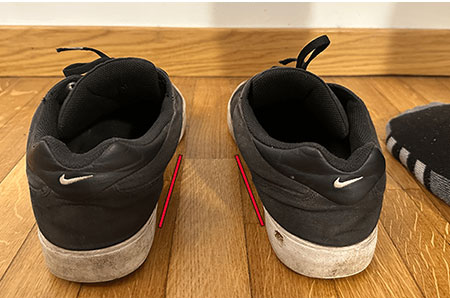
Now let’s take a look at an image of a child with flat feet and overpronation standing barefoot. Do you notice how the feet are collapsing inwards?
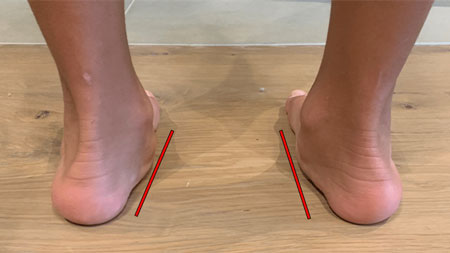
We can see the exact same foot position even when the child is wearing shoes, which clearly are not doing a good job of supporting the child’s feet.

Anatomy of a Shoe: Two Essential Parts and Their Functions
A typical shoe has several key components, each serving a specific purpose in protecting and comforting the foot. The outsole, the bottom part of the shoe, makes direct contact with the ground, and it undergoes the most wear and tear. This part of the shoe is built for cushioning, support, durability and grip.
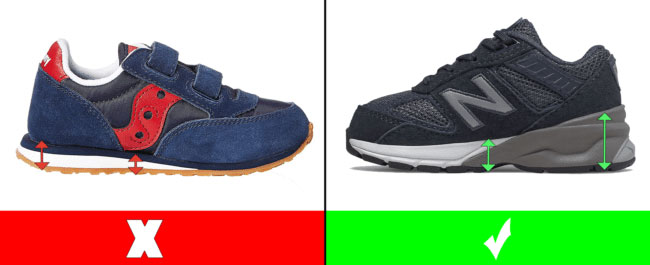
The heel counter of the shoe is the back part that provides heel and ankle support.

Materials also play a vital role. Rubber and synthetic compounds offer longevity for the sole, while breathable fabrics used in uppers ensure comfort and prevent overheating. When these parts wear down, they offer clues about how a child walks. Uneven soles or insoles can indicate gait irregularities. Over time, materials will compress differently based on the frequency and type of movement, also suggesting particular practices or postures adopted by the child.
Mastering the nuances of a shoe’s structure and materials equips you with the ability to understand what lies beneath the wear patterns you observe. Remember, a shoe that’s worn out isn’t just a sign to get a new pair; it’s a map to your child’s unique foot behavior, one that you can use to ensure their continuous comfort and health.
Step-by-Step Guide to Assessing Shoe Wear in Kids’ Footwear
Start with a visual inspection. Look at the outsole, which should display an even wear pattern. If the tread on the outsole is more worn down on one side, this may indicate an imbalance in the way your child walks or runs.
1️⃣ Consider a shoe that’s worn down on the inside edge. This wear might suggest that your child overpronates, which means they roll their feet inward as they walk. Left unchecked, overpronation can lead to discomfort and alignment issues. To mitigate this, supportive shoes with specialized insoles can be a game-changer.
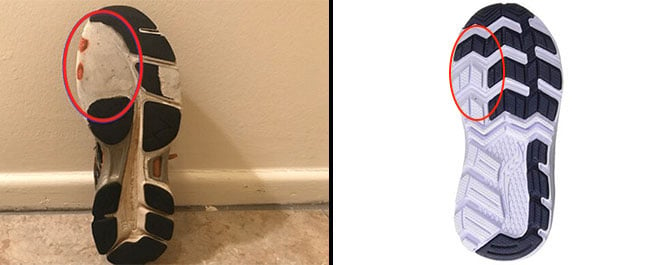
2️⃣ Consider a shoe that’s showing excessive wear on the outside heel and forefoot. This might indicate supination, where your child tends to walk on the outer edges of their feet. This can lead to ankle instability and an increased risk of sprains. Shoes with cushioning and a flexible sole might help balance their steps.
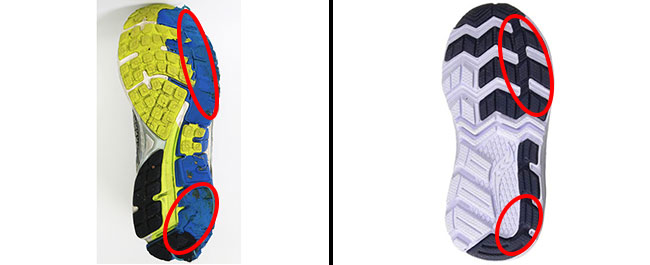
Check for physical signs of wear. This includes an uneven heel that suggests your child may be overpronating (rolling their feet inward) or underpronating (rolling outward). Be alert for any places where the sole might be compressed or the upper part of the shoe shows unusual creases or wear.
Use this assessment as a preventive measure. If signs of uneven wear are detected early, corrective inserts or specific types of shoes can help address the issue. Keeping an eye out for these patterns is essential to ensure your child’s feet develop healthily.
Flat feet, evident by wear across the entire sole, can have their own set of complications. Children with flat feet may experience fatigue quicker than their peers. In this scenario, supportive shoes with arch support may make a world of difference in their comfort and mobility.
Maintaining Healthy Feet: Shoe Selection and Care Tips for Parents
As a shoe fitter, I understand that keeping pace with growing feet can be a challenge, but the stakes are high. Incorrect or worn-out shoes can lead to discomfort and long-term problems.
To safeguard your child’s feet, place priority on FIT. This means finding shoes that accommodate their foot shape, providing enough room for toes to wiggle without being too loose. For this reason, I developed the most effective way to determine your child’s exact foot size and shape from your home and will personally assist you with a custom fitting tailored to your child’s individual needs. This easy-to-follow method allows parents to accurately determine their child’s exact foot length and shape (narrow, medium, wide, extra wide, high instep).
Contact Me for Specific Shoe Recommendations Tailored to Your Child’s Unique Foot Shape
Your child’s shoe needs can vary depending on their age, activity level, and any specific foot conditions they may have. If you have any questions or need any further assistance, you can also contact me via email and I will get back to you as soon as possible. I am happy to help you find the correct pair of shoes for your child.
I have helped hundreds of families find the correct pair of shoes for their children online, and I am confident I will be able to help you as well.
By the way, I’ve seen a couple of cases where the front part of the shoe caves in first. It often happens with active kids who love to run and play. Although it’s normal for kids to be active, make sure they have shoes that can keep up with their lifestyle. Durable shoes with a reinforced toe-box might be the solution here.
Always pay attention to what your child’s footwear is telling you. After identifying potential issues, it wouldn’t hurt to consult a pediatric podiatrist for personalized advice based on the wear patterns you’ve spotted.
Let me know in the comments section below if you have any questions and I will respond to you as soon as possible.


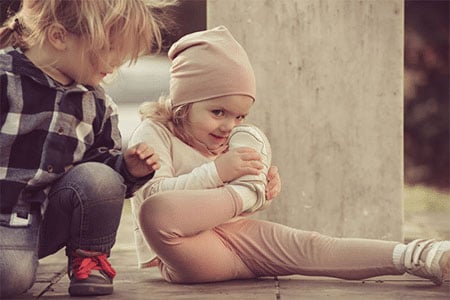
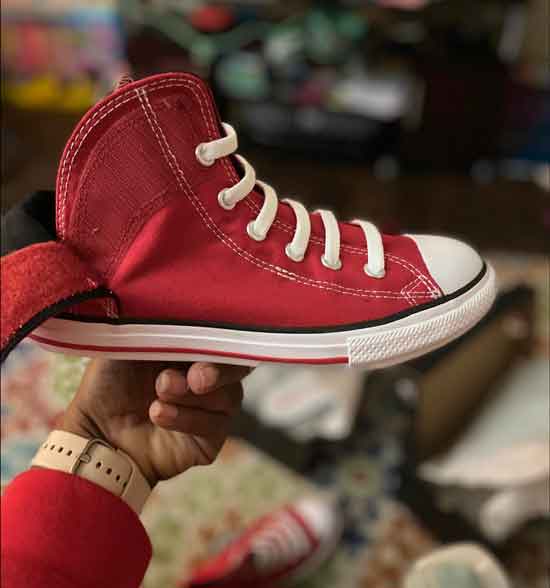
Hello, can you recommend a shoe for my child who has very flat feet? His foot shape is wide.
Hello Margarita,
I suggest that you use this resource as it has specific shoe recommendations for children who have flat and wide feet: Best Wide Shoes for Kids with Flat Feet – Supportive and Round Toe-Boxes
Thank you so much!!!!